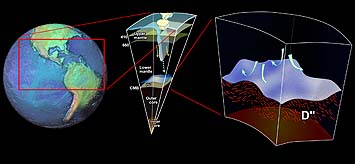|

Research hints at a very active
inner Earth area as depicted by these drawings. The image
on the left is of Earth. The center image shows a section
of Earth and its main divisions (solid inner core, liquid
outer core, and the lower mantle, including the D"
zone). The image on the right is a close-up of the D"
region, where researchers found strong topographical variations
here. Image courtesy of E.
Garnero
|
October 11, 2004
Seismology research reveals the dynamic inner
workings of Earth
By Skip Derra, Arizona State University
At the surface of Earth, life on a geologic scale is calm and
peaceful save the occasional earthquake caused by the rub and
slip of Earth's tectonic plates. But below Earth's surface,
scientists are beginning to find a far more dynamic and tumultuous
region than previously thought.
Deep inside Earth, where the mantle meets the molten iron core,
researchers are finding telltale signs of what could be a highly
active area filled with exotic forms and substances.
Seismologist Thorne Lay, professor of Earth sciences and director
of the Institute of Geophysics and Planetary Physics at UCSC,
is part of a team of scientists studying the structure of the
mineralogical fabric near the base of Earth's mantle. They reported
their latest findings in the October 8 issue of the journal
Science.
"This study demonstrates that the material at the base
of the mantle is deforming in ways that are much more complicated
than the simple structures we had inferred from earlier work,"
Lay said.
The lead author on the paper is Arizona State University seismologist
Edward Garnero. The other coauthors are Valerie Maupin of the
University of Oslo, Norway, and Matthew Fouch of Arizona State.
The researchers deciphered unusual layering in Earth's deep
interior that may contain clues about how the interior churns
and convects, and the relationship between Earth's interior
and its ever-evolving surface.
"Over very long periods of time, the Earth's rocks behave
fluidly," Lay said. "If you picked up a chunk of the
mantle it would feel like hard, dense rock. But over tens of
millions of years, hard rock can flow like putty, and that's
what is happening in the deep mantle. It's flowing in order
to cool off, with hot rock rising to the surface and cooling
off, and cold rock sinking back down."
According to Garnero, the base of the mantle is probably the
most exotic part of Earth's interior. "In this area, where
the mantle meets the core halfway to Earth's center (2,900 km
below Earth's surface), the change in density is several times
greater than what we find at Earth's surface, as represented
by air and rock," Garnero said.
The deep mantle region the team probed is a several-hundred-kilometer-thick
zone called D" (D double prime), which is where the silicate
rock lower mantle meets Earth's liquid iron outer core. The
researchers used seismic waves generated by earthquakes to probe
this region.
They measured unique directional vibrations of seismic waves
produced by South American earthquakes and recorded in North
America, permitting a detailed probing of D" beneath Central
America and the Caribbean Sea. The scientists found unexpected
wave vibration directions from these waves and showed the deepest
mantle to be the source of these wave-motion alignment changes.
These observations can be explained by tilting of the once
horizontal rock fabric in the lower mantle by 20 degrees, resulting
in contortions of the mineralogical fabric that must vary over
relatively short distances (hundreds of kilometers). The seismic
readings indicate a complex area that churns and chugs as the
liquid iron core roils at the bottom of the rocklike mantle.
"We were detecting changes in the directional dependency
over a relatively small size scale of a few hundred kilometers,"
Garnero said. "We think there must be currents and turbulence
over geologic-type timescales that are really quite vigorous
and which are occurring at short lengths in order to stir things
in such a way as to give this preferred alignment of the material."
The seismic waves may be detecting areas where there are dramatic
differences in the types of materials inside Earth.
"What hasn't been appreciated is that in the deepest mantle
there are incredible changes from place to place geographically
over short distances," Garnero said. "These changes
represent a very dynamic mantle system."
"The center of the planet is thought to be as hot as the
surface of the Sun, so this is a planet that is going to take
some time to cool off," he added. "It cools off through
this stirring and internal mixing."
According to Lay, a massive new seismic monitoring project funded
by the National Science Foundation (NSF) promises to give scientists
an even better view of Earth's deepest layers. Among other things,
the NSF EarthScope project will add 2,000 new seismic monitoring
sites across the United States.
"Our study used the relatively sparse data presently
available, and in the future we expect to have much better resolution,"
Lay said. "It will be like a giant telescope looking down
into the Earth that we can use to study processes 1,700 miles
deep and understand how the mantle is deforming and flowing."
Garnero said this research is helping reshape the contemporary
view of the inner workings of Earth.
"In the past 10 to 15 years we have come to appreciate
the importance of deciphering the lowest couple of hundred kilometers
of the mantle. Doing so is critical in understanding how the
interior of Earth actually turns and convects, and drives these
motions that we see at the surface," Garnero said. "This
research supports a new view of the deepest mantle, where the
evolution and dynamics of Earth as a whole cannot be understood
without first deciphering the D" layer."
UCSC science writer Tim
Stephens contributed to this article.
Return to Front Page